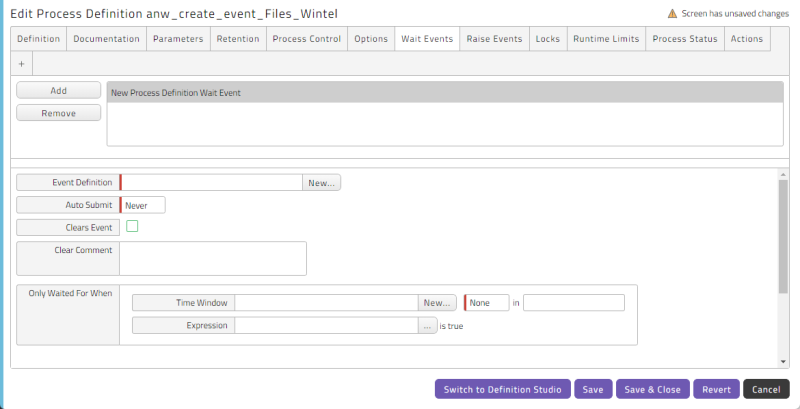Process Definitions: Wait Events Tab
Raise Events and Wait Events are not specific types of event objects. Rather, they are fields on a Process Definition or Chain Definition. A Process Definition or Chain Definition with a Wait Event will not execute until that event is raised.

Note: If you make extensive use of alerts and/or notifications, Redwood recommends the Active Monitoring module, because it lets you configure alerts and notifications centrally.
If you configure a Process or Chain Definition to wait on multiple Event Definitions (Event1, Event2, Event3, etc.), AND logic is used. This means that the Process or Chain will only execute when all Events have been raised (e.g, Event1 FileA arrives AND Event2 FileB arrives AND Event3 FileC arrives).
If you define multiple File Event Definitions inside a single Event Definition (Event1), OR logic is used when raising the Event. This means that the Process or Chain will execute when any one Event is raised (e.g, Event1 FileA arrives OR Event1 FileB arrives OR Event1 FileC arrives).
A process that is waiting for an event is given the EventWait status.
Note: A process waits only once for a specific event. So if the event was raised, but the process did not start (for example, due to the closing of a Queue), the process does not wait again for an event from the same event definition the next time the Queue is released.
The Wait Events tab of the Process Definition editing pop-up window includes the following controls.
| Name | Description |
|---|---|
| Event Definition | The event the Process Definition should wait for. |
| Auto Submit |
Lets you control what happens when the Wait Event is raised. Make sure that all parameters (if any) have default parameter values and a default Queue is set. The options are as follows.
Note: A process that is waiting for an event must be scheduled before it reaches the EventWait status. |
| Clears Event | If this is box is checked, the process triggered by the Wait Event will clear the event. This allows other processes that share this Wait Event and execute later to react when the Wait Event is next raised. |
| Clear Comment | The comment to be automatically logged by this process when the Wait Event is cleared. |
| Only Waited For When > Time Window |
Lets you use a Time Window to control whether the Wait Event should trigger the process. You can specify that the Time Window must be open or closed in a particular time zone in order for the Wait Event to apply. A few notes about this setting:
|
| Only Waited For When > Expression |
Lets you control whether the process is triggered by the Wait Event using a Boolean REL expression. If the REL expression evaluates to For example: |
Note: If both a Time Window and a Boolean REL expression are associated with a Wait Event, the REL expression will always be evaluated first. In this case, the Time Window will be evaluated only if the REL expression evaluates to true.